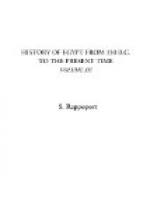Young had his attention called to the Rosetta Stone by accident, and his usual rapacity for knowledge at once led him to speculate as to the possible aid this tri-lingual inscription might give in the solution of Egyptian problems. Resolving at once to attempt the solution himself, he set to work to learn Koptic, which was rightly believed to represent the nearest existing approach to the ancient Egyptian language. His amazing facility in the acquisition of languages stood him in such good stead that within a year of his first efforts he had mastered Koptic and assured himself that the ancient Egyptian language was really similar to it, and had even made a tentative attempt at the translation of the Egyptian scroll. His results were only tentative, to be sure, yet they constituted the very beginnings of our knowledge regarding the meaning of hieroglyphics. Just how far they carried has been a subject of ardent controversy ever since. Not that there is any doubt about the specific facts; what is questioned is the exact importance of these facts. For it is undeniable that Young did not complete and perfect the discovery, and, as always in such matters, there is opportunity for difference of opinion as to the share of credit due to each of the workers who entered into the discovery.
Young’s specific discoveries were these: (1) that many of the pictures of the hieroglyphics stand for the names of the objects actually delineated; (2) that other pictures are sometimes only symbolic; (3) that plural numbers are represented by repetition; (4) that numerals are represented by dashes; (5) that hieroglyphics may read either from the right or from the left, but always from the direction in which the animals and human figures face; (6) that proper names are surrounded by a graven oval ring, making what he called a cartouche; (7) that the cartouches of the preserved portion of the Rosetta Stone stand for the name of Ptolemy alone; (8) that the presence of a female figure after such cartouches, in other inscriptions, always denotes the female sex; (9) that within the cartouches the hieroglyphic symbols have a positively phonetic value, either alphabetic or syllabic; and (10) that several different characters may have the same phonetic value.
Just what these phonetic values are, Doctor Young pointed out in the case of fourteen characters, representing nine sounds, six of which are accepted to-day as correctly representing the letters to which he ascribed them, and the three others as being correct regarding their essential or consonantal element. It is clear, therefore, that he was on the right track thus far, and on the very verge of complete discovery. But, unfortunately, he failed to take the next step, which would have been to realise that the same phonetic values given the alphabetic characters within the cartouches were often ascribed to them also when used in the general text of an inscription; in other words, that the use of an alphabet was not confined to proper names. This was the great secret which Young missed, but which his French successor, Jean Francois Champollion, working on the foundation that Young had laid, was enabled to ferret out.




